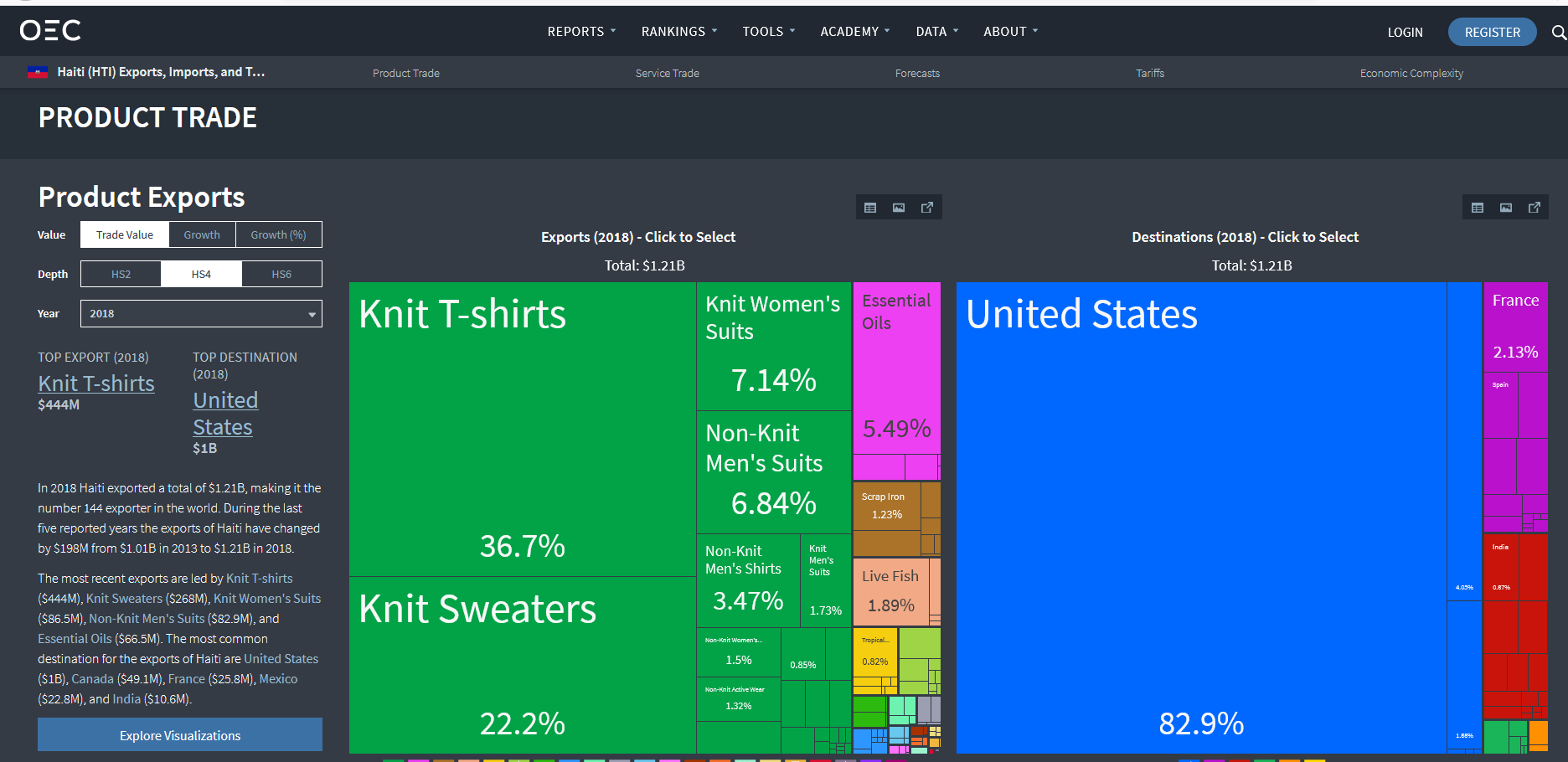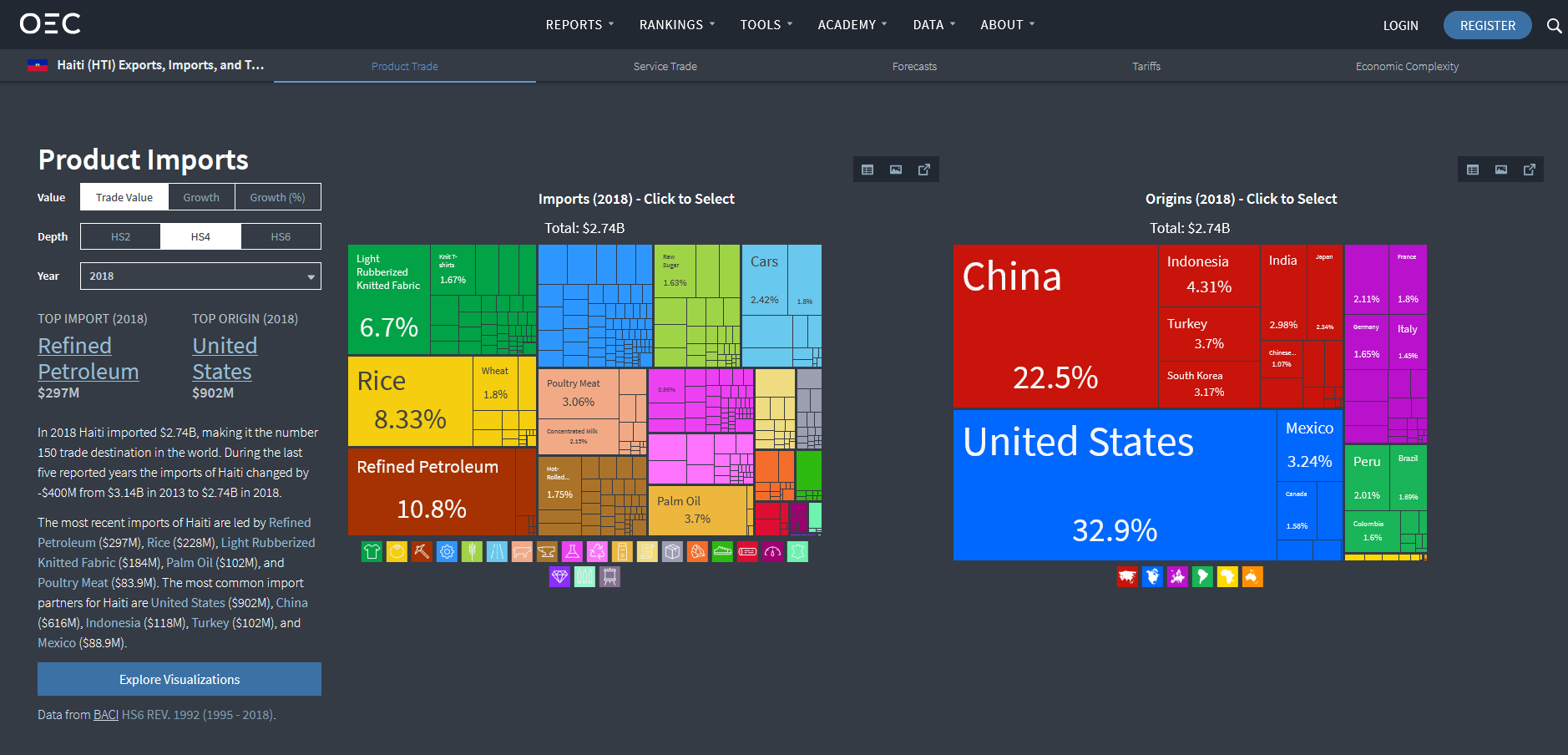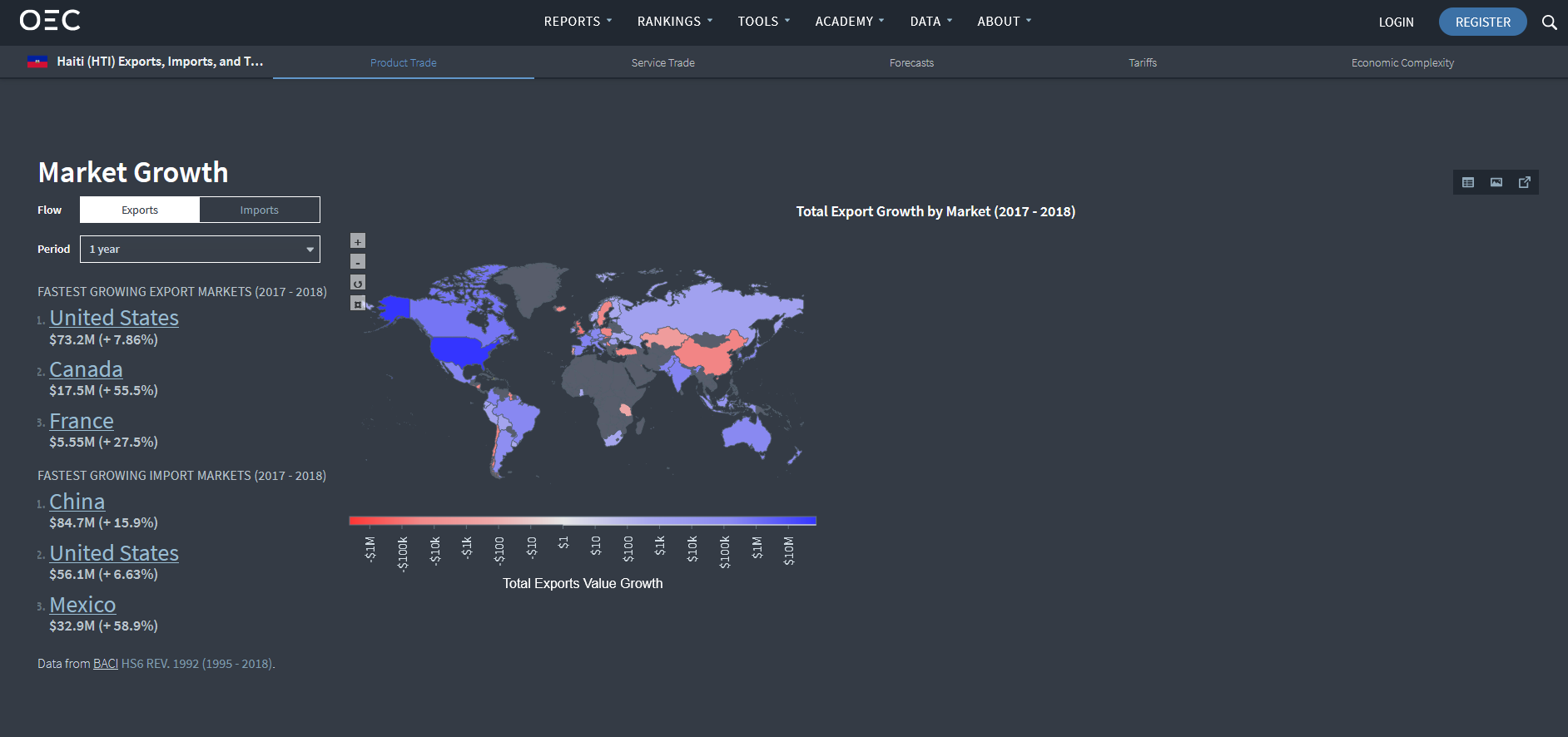About Haiti
2020 Convert all below figures to "COUNTRY LOCK"
Econ Complexity (2018): -1.52, Rank 130 of 137 Product Exports (2018): $1.21B, Rank 144 of 222
Exports Per Capita (2018): $109, Rank 210 of 219 Product Imports (2018): $2.74B, Rank 150 of 221
Imports Per Capita (2018): $246, Rank 207 of 219 Service Exports (2015): $87.7M, Rank 158 of 170
Service Imports (2015): $912M, Rank 125 of 170 GDP (2018): $9.66B, CURRENT US$ Rank 142 of 196
GDP growth (2008 - 2018): 47.5%, CURRENT US$ Rank 83 of 196 GDP PC (2018): $868, CURRENT US$Rank 176 of 196
GDP PC GROWTH (2008 - 2018): 27.9%, CURRENT US$ Rank 87 of 196
Overview: In 2018 Haiti was the number 142 economy in the world in terms of GDP (current US$), the number 144 in total exports, the number 150 in total imports, and the number 130 most complex economy according to the Economic Complexity Index (ECI). In 2018, Haiti exported $1.21B and imported $2.74B, resulting in a negative trade balance of -$1.53B. In 2018, Haiti's exports per capita were $109 and its imports per capita were $246.
Trade: The top exports of Haiti are Knit T-shirts ($444M), Knit Sweaters ($268M), Knit Women's Suits ($86.5M), Non-Knit Men's Suits ($82.9M), and Essential Oils ($66.5M). The top imports of Haiti are Refined Petroleum ($297M), Rice ($228M), Light Rubberized Knitted Fabric ($184M), Palm Oil ($102M), and Poultry Meat ($83.9M).
Destinations: Haiti exports mostly to United States ($1B), Canada ($49.1M), France ($25.8M), Mexico ($22.8M), and India ($10.6M), and imports mostly from United States ($902M), China ($616M), Indonesia ($118M), Turkey ($102M), and Mexico ($88.9M).
Location: Haiti borders Dominican Republic by land and Bahamas, Colombia, Cuba, Jamaica, and Turks and Caicos Islands by sea.



Source OEC
2032 Reports CURRENT PROJECTIONS ARE AVAILABLE INTERNALLY.
===========================_________________________________-=======================================
Overview
09/07/2021
Haiti is regularly affected by natural disasters such as floods, earthquakes, landslides, and droughts. At least 4.4 million people in Haiti (about 40% of the population) were in need of humanitarian assistance as at March 2021; almost 49% of them are children. Food insecurity persists across the country, with approximately 4.1 million people in acute need of food assistance. This is caused by the combined effects of natural hazards and poor socioeconomic conditions. In November 2020, 69% of 11,600 households surveyed reported a decrease in their incomes as a result of the pandemic. During 2019–2020, four million children did not have access to education. Haiti experiences political and social turbulence because of gang violence, which has been on the rise since the second half of 2020. Since June 2021, approximately 18,100 people have been displaced by armed violence, and about 1.5 million have been affected by the inability to access basic services in Port-au-Prince during clashes between gangs. The assassination of President Jovenel Moïse on 7 July adds a new element of political instability to the current crisis, although the potential developments and consequences of the event are not yet clear. ?
INFORM measures Haiti's risk of humanitarian crisis and disaster for 2019 to be high at 6.5/10. Lack of Coping Capacity is of particular concern, at 7.4/10.?
Latest Developments
29/08/2022
One year after the 7.2 magnitude earthquake struck southeastern Haiti, funding shortages have delayed the reconstruction of schools. More than 250,000 children remain without adequate access to education as most of the 1,250 damaged schools and learning spaces have not been repaired or rebuilt. Gang violence in Port-au-Prince has constrained the mobility of humanitarian agencies, further delaying reconstruction. ?
Humanitarian Access
07/07/2022
HIGH CONSTRAINTS
Haiti faced High humanitarian access constraints in the past six months, scoring 3/5 in ACAPS Humanitarian Access Index. The humanitarian access situation remained stable.
For more information you can consult our latest Global Humanitarian Access Overview – July 2022.
Update from the October 2021 Risk Analysis
06/04/2021
MEDIUM RISK LEVEL
Worsening insecurity and deteriorating living conditions in Haiti increase displacement through Central America, resulting in high food, shelter, and protection needs for migrants and asylum seekers
As ACAPS anticipated, the assassination of the prime minister and the spread of the territorial control of gangs increased violence and political instability in Haiti during the second half of 2021. Gangs control approximately 60% of the country, affecting ports, roads, and food storage areas.? Aside from the impact of the 14 August 2021 earthquake, roadblocks erected by gangs also affect the southern departments, and there are no alternative routes.? As ACAPS also anticipated, the continued escalation of violence in Haiti has increased migration flows to the US through Central America, mainly Colombia and Panama.? In 2021, over 126,000 Haitians crossed the border between Colombia and Panama. This number is more than the total in the previous 11 years (118,000 between 2009–2020).? In 2022, 100–150 Haitians have been arriving weekly at the Colombia-Panama border.? Several boats with migrants have been shipwrecked in the Caribbean Sea while en route to Panama.? Although not anticipated by ACAPS, Mexico is receiving a high number of migrants. 14,000 Haitian asylum seekers have been deported to the country to await the US Government’s response.? Shelters at Mexico’s borders have overflowed, and migrants lack WASH, health, education, and food security services.?
Key Priorities
07/03/2022
Food Security: Expected declines in crop production caused by below-average and irregular rains since March, continued inflation, and the effects of COVID-19 containment measures are affecting food security across the country. The 14 August earthquake in southern Haiti has also had a major impact on food security as a result of crop losses, impacts on livelihoods, and the destruction of the food production infrastructure, mainly in the regions of Sud, Grand'Anse, and Nippes. 40.8% of the population is undernourished, and at least 1,338,000 people in Haiti are in IPC 4. ?
Protection: Political instability and territorial control by criminal gangs have expanded in Haiti since the assassination of President Moïse in July. Armed clashes, intimidations, sexual violence, assassinations, and kidnapping threaten the lives and safety of the population. Kidnapping has become a main source of financing for criminal gangs. Sexual violence has been used as a weapon of control and imposition of territorial dominance; girls and women are particularly vulnerable to it, especially when travelling on public transport, returning from school, or during kidnappings. Despite underreporting, at least 75 people a month are victims, especially children and women. The lack of access to health services prevents the provision of physical and psychological help to this population. There are also reports of sexual violence and abuse at border crossings with the Dominican Republic. Men also suffer sexual abuses and violence, often as an initiation rite into criminal gangs. ?
WASH: The 14 August earthquake caused a lack of access to clean water in southern Haiti as a result of the damage and destruction of infrastructure used to supply drinking water. On the other hand, water shortages in Port-au-Prince are mainly caused by the lack of fuel to feed power plants resulting from blockades and restrictions imposed by criminal gangs. This puts the population at risk of spreading waterborne diseases. Humanitarian workers have had to restrict WASH operations because of protection risks to humanitarian staff and shortages of fuel for mobilisation. ?
Armed Gang Violence
22/07/2022
Since July 2021, following the assassination of Prime Minister Jovenel Moïse, the socio-political crisis has exacerbated. The crisis has left space for increased armed gangs’ activity and fight for territorial control. Since 24 April 2022, violence has increased in the city of Port-au-Prince and metropolitan area. ?
The upsurge in violence in Port-au-Prince has resulted in 934 killings, 684 wounded and 680 people kidnapped between January and June 2022. Threats, forced recruitment, kidnapping, robbery, and sexual violence are reported. Since the end of April to date at least 17,000 people have been displaced from their homes. Displaced people have taken refuge in makeshift shelters or host families. ?
In Cité Soleil, a commune of Port-au-Prince metropolitan area, confinements and armed clashes between armed gangs have restricted access to goods and services. The inability to bring in water tankers has increased the need for drinking water. Electricity, health care and sanitation services have also been affected. Food security has deteriorated, as livelihoods shortages, price increases and fuel shortages have decreased the availability and accessibility of food. Access to humanitarian aid is limited, humanitarian responders are unable to reach people in need in some areas affected by fighting or road blockages by armed gangs. ?
Political Instability
14/10/2021
Since President Jovenel Moïse took office in February 2017, Haiti has faced repeated periods of civil unrest. Recurrent protests took place between 2018–2021. Among the causes of these demonstrations were the rejection of the election results, rising fuel prices, discontent over stark socioeconomic inequalities, and the lack of adequate social services across the country. ?
The assassination of Jovenel Moïse on 7 July 2021 was followed by an escalation in gang violence, with shootings and blockades reported – particularly in the capital city of Port-au-Prince. ?Political instability has increased as Prime Minister Ariel Henry was linked to the assassination of the president on 14 September. Presidential elections scheduled for 26 September were postponed to 7 November, but the dismissal of the Provisional Electoral Council on 28 September could again delay the process. ?
Since July 2021, gang violence remains a concern and a driver of humanitarian needs in Haiti. Confrontations between urban gangs have caused the displacement of around 19,000 people, especially in Delmas, Fontamara, and Martissant neighbourhoods of Port-au-Prince, and resulted in the damage of thousands of houses. ? Gang violence has left around 1,100,000 people in need of immediate humanitarian assistance. ?
Updates on conditions in the country


